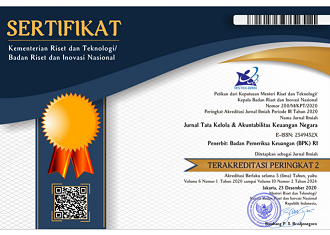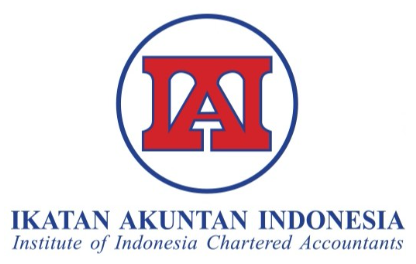Measuring Employee Readiness for Knowledge Management Implementation in the Audit Board of the Republic of Indonesia
DOI:
https://doi.org/10.28986/jtaken.v9i1.1007Keywords:
Knowledge management, Employee readiness, SEMAbstract
The Audit Board of the Republic of Indonesia is one of the largest public institutions with frequent job rotations and high employee turnover. The current COVID-19 pandemic, which has forced employees to adopt work from home whether they are ready or not, has compelled the organization to implement knowledge management successfully urgently. Employee readiness is one of the critical factors in the implementation of knowledge management. If the employee is not ready, it will lead to the organization’s failure. This study aims to measure the level of employee readiness in BPK to implement knowledge management by using the intention to be involved in the SECI (Socialization, Externalization, Combination, and Internalization) process. The analysis was conducted by using SEM (Structural Equation Modelling). The result reveals that employees of BPK are ready to implement knowledge management. This is shown by the development of the SEM analysis and by the results of descriptive statistics with high values. The SEM analysis displays 14 out of 16 items considered the most representative dimensions in the SECI Process.
References
Abdel-Ghany, M. M. M. (2014). Readiness for change, change beliefs, and resistance to change of extension personnel in the New Valley Governorate about a mobile extension. Annals of Agricultural Sciences, 59(2), 297-303. DOI: 10.1016/j.aoas.2014.11.019
Akil, S. R., Soemaryani, I., Hilmiana, H., & Joeliaty, J. (2021). Determinant factors of intellectual capital for improving public sector innovation: An empirical study from Indonesia. The Journal of Asian Finance, Economics, and Business, 8(12), 421-429.
Al-Ahbabi, S. A., Singh, S. K., Balasubramanian, S., & Gaur, S. S. (2018). Employee perception of the impact of knowledge management processes on public sector performance. Journal of knowledge management, 23(2), 351-373. DOI: 10.1108/JKM-08-2017-0348
Bučková, J. (2015). Knowledge management in public administration institutions. Procedia Economics and Finance, 34, 390-395. DOI: 10.1016/S2212-5671(15)01645-7
Conner, B., & Johnson, E. (2017, November). Descriptive statistics. American Nurse Today, 12(11), 52-55. Retrieved from https://www.myamericannurse.com/wp-content/uploads/2017/11/ant11-Research-101-1017a.pdf
Dalkir, K. (2013). Knowledge management in theory and practice. Oxford UK: Elsevier Butterworth–Heinemann
Edosio, U. (2014). Knowledge management concept. In Knowledge Management Conference, Bradford, UK.
González, V., René, E., Hidalgo, R., & Alberto, J. (2016). Knowledge management metrics for public organizations: A literature review-based proposal. ArXiv. DOI: 10.13140/RG.2.2.24281.11368/1
Karim, N. S. A., Razi, M. J. M., & Mohamed, N. (2012). Measuring employee readiness for knowledge management using intention to be involved with KM SECI processes. Business Process Management Journal, 18(5), 777-791. DOI: 10.1108/14637151211270153
Marouf, L. N., & Agarwal, N. K. (2016). Are faculty members ready? Individual factors affecting knowledge management readiness in universities. Journal of Information & Knowledge Management, 15(03), 1650024. DOI: 10.1142/S0219649216500246
Mohajan, H. K. (2019). Knowledge sharing among employees in organizations. Journal of Economic Development, Environment, and People, 8(1), 52. DOI: 10.26458/JEDEP.V8I1.612
Nonaka, I., Byosiere, P., Borucki, C. C., & Konno, N. (1994). Organizational knowledge creation theory: a first comprehensive test. Int. Bus. Rev, 3, 337–351. DOI: 10.1016/0969-5931(94)90027-2
Razak, N. A., Pangil, F., Zin, M. L. M., Yunus, N. A. M., & Asnawi, N. H. (2016). Theories of knowledge sharing behavior in business strategy. Procedia Economics and Finance, 37, 545-553. DOI: 10.1016/S2212-5671(16)30163-0
Razi, M. J. M., Karim, N. S. A., & Mohamed, N. (2015). SECI Process and its predictors: Behavioral intention from a socio-technical perspective. Journal of Computational and Theoretical Nanoscience, 21(6), 2130-2133. DOI:10.1166/asl.2015.6232
Rusly, F., Sun, P. Y. T., & Corner, J. L. (2014). The impact of change readiness on the knowledge-sharing process for professional service firms. Journal of Knowledge Management, 18, 687-709. DOI: 10.1108/JKM-01-2014-0007
Rusly, F. H., Corner, J. L., & Sun, P. (2012). Positioning change readiness in knowledge management research. Journal of Knowledge Management, 16(2), 329–355. DOI: 10.1108/13673271211 218906
Salwa, M., & Susanty, A. I. (2016). Measuring employee readiness for knowledge management in PT. Mineral Indonesia. Pertanika Journal of Social Science and Humanities, 24(S), 27-34.
Samaranayake, S. U., & Takemura, T. (2017). Employee readiness for organizational change: a case study in an export-oriented manufacturing firm in Sri Lanka. Eurasian Journal of Business and Economics, 10(20), 1-16.
Sayyadi Tooranloo, H., Ayatollah, A. S., & Alboghobish, S. (2018). Evaluating knowledge management failure factors using intuitionistic fuzzy FMEA approach. Knowledge and Information Systems, 57(1), 183-205. DOI: 10.1007/s10115-018-1172-3
Sujatha, R. & Krishnaveni, R. (2018). Knowledge creating ba as a determinant of work performance of employees: An empirical analysis among pump manufacturing firms in South India. Asia Pacific Management Review, 23(1), 45-52. DOI: 10.1016/j.apmrv.2017.01.006
Downloads
Submitted
Accepted
Published
How to Cite
Issue
Section
License

Jurnal Tata Kelola dan Akuntabilitas Keuangan Negara is licensed under
a Creative Commons Attribution-ShareAlike 4.0 International License




















